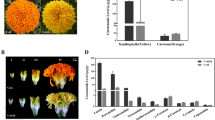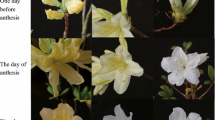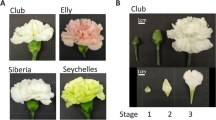Abstract
Marigold (Tagetes erecta L.) flower petals synthesize and accumulate carotenoids at levels greater than 20 times that in leaves and provide an excellent model system to investigate the molecular biology and biochemistry of carotenoid biosynthesis in plants. In addition, marigold cultivars exist with flower colors ranging from white to dark orange due to ¿100-fold differences in carotenoid levels, and presumably similar changes in carbon flux through the pathway. To examine the expression of carotenoid genes in marigold petals, we have cloned the majority of the genes in this pathway and used these to assess their steady-state mRNA levels in four marigold cultivars with extreme differences in carotenoid content. We have also cloned genes encoding early steps in the biosynthesis of isopentenyl pyrophosphate (IPP), the precursor of all isoprenoids, including carotenoids, as well as two genes required for plastid division. Differences among the marigold varieties in the expression of these genes suggest that differences in mRNA transcription or stability underlie the vast differences in carotenoid synthesis and accumulation in the different marigold varieties.
Similar content being viewed by others
References
Bartley, G.E. and Scolnik, P.A. 1993. cDNA cloning, expression during development and genome mapping of Psy-2, a second tomato gene encoding phytoene synthase. J. Biol. Chem. 267: 5036–5039.
Bouvier, F., Hugueney, P., d'Harlingue, A., Kuntz, M. and Camara, B. 1994. Xanthophyll biosynthesis in chromoplasts: isolation and molecular cloning of an enzyme catalyzing the conversion of 5,6-epoxycarotenoids into ketocarotenoid. Plant J. 6: 45–54.
Bouvier, F, d'Harlingue, A., Suire, C., Backhaus, R.A. and Camara, B. 1998. Dedicated roles of plastid transketolases during the early onset of isoprenoid biogenesis in pepper fruits. Plant Physiol. 117: 1423–1431.
Bramley, P.M., Teulieres, C., Blain, I., Bird, C. and Schuch, W. 1992. Biochemical characterization of transgenic tomato plants in which carotenoid synthesis has been inhibited through expression of antisense RNA to pTOM5. Plant J. 2: 343–349.
Burbulis, I.E. and Winkel-Shirley, B. 1999. Interactions among enzymes of the Arabidopsis flavonoid biosynthetic pathway. Proc. Natl. Acad. Sci. USA 96: 12929–12934
Burkhardt, P.K., Beyer, P., Wunn, J., Kloti, A. and Armstrong, G.A. 1997. Transgenic rice (Oryza sativa) endosperm expressing daffodil (Narcissus pseudonarcissus) phytoene synthase accumulates phytoene, a key intermediate of provitamin A biosynthesis. Plant J. 11: 1071–1078.
Camara, B. 1993. Plant phytoene synthase complex: component enzymes, immunology, and biogenesis. Meth. Enzymol. 214: 352–365.
Camara, B., Hugueney, P., Bouvier, F., Kuntz, M. and Moneger, R. 1995. Biochemistry and molecular biology of chromoplast development. Int. Rev. Cytol. 163: 175–246.
Candau, R., Bejarano, E.R. and Cerda-Olmedo, E. 1991. In vivo channeling of substrates in an enzyme aggregate for β-carotene biosynthesis. Proc. Natl. Acad. Sci. USA 88: 4936–4940.
Colletti, K.S., Tattersall, E.A., Pyke, K.A., Froelich, J.E., Stokes, K.D. and Osteryoung, K.W. 2000. Placement of the chloroplast division apparatus is mediated by a homologue of the bacterial cell division site-determining factor MinD. Curr Biol, in press.
Cunningham, F.X. Jr. and Gantt, E. 1998. Genes and enzymes of carotenoid biosynthesis in plants. Annu. Rev. Plant Physiol. 49: 557–583.
Cunningham, F.X. Jr., Sun, Z.R., Chamovitz, D., Hirschberg, J. and Gantt, E. 1994. Molecular structure and enzymatic function of lycopene cyclase from the cyanobacterium Synechococcus sp. strain PCC7942. Plant Cell 6: 1107–1121.
Cunningham, F.X. Jr., Pogson, B., Sun, Z., McDonald, K.A., DellaPenna, D. and Gantt, E. 1996. Functional analysis of the β and ɛ lycopene cyclase enzymes of Arabidopsis reveals a mechanism for control of cyclic carotenoid formation. Plant Cell 8: 1613–1626.
de Boer, P., Crossley, R.E. and Rothfield, L.I. 1989. A division inhibitor and a topological specificity factor coded for by the minicell locus determine proper placement of the division septum in E. coli. Cell 56: 641–649.
Delgado-Vargas, F. and Paredes-Lopez, O. 1997. Effects of enzymatic treatments of marigold flowers on lutein isomeric profiles. J. Agric. Food Chem. 45: 1097–1102.
DellaPenna, D. 1999. Nutritional genomics: manipulating plant micronutrients to improve human health. Science 285: 375–379.
Demmig-Adams, B. and Adams, W.W. 1996. The role of xanthophyll cycle carotenoids in the protection of photosynthesis. Trends Plant Sci. 1: 21–26.
Emanuelsson, O., Nielsen, H. and von Heijne, G. 1999. ChloroP, a neural network-based method for predicting chloroplast transit peptides and their cleavage sites. Prot. Sci. 8: 978–984.
Fraser, P.D., Kiano, J.W., Truesdale, M.R., Schuch, W. and Bramley, P.M. 1999. Phytoene synthase-2 enzyme activity in tomato does not contribute to carotenoid synthesis in ripening fruit. Plant Mol. Biol. 40: 687–698.
Gau, W., Ploschke, H.-J. and Wuensche, C. 1983. Mass spectrometric identification of xanthophyll fatty acid esters from marigold flowers (Tagetes erecta) obtained by high-performance liquid chromatography and craig counter-current distribution. J. Chromatogr. 262: 277–284.
Giuliano, G., Bartley, G.E. and Scolnik, P.A. 1993. Regulation of carotenoid biosynthesis during tomato development. Plant Cell 379–387.
Harker, M. and Hirschberg, J. 1998. Molecular biology of carotenoid biosynthesis in photosynthetic organisms. Meth. Enzymol. 297: 244–263.
Harker, M. and Bramley, P.M. 1999. Expression of prokaryotic 1-deoxy-D-xylulose-5-phosphatases in Escherichia coli increases carotenoid and ubiquinone biosynthesis. FEBS Lett. 448: 115–119.
Hirschberg, J. 1999. Production of high-value compounds: carotenoids and vitamin E. Curr. Opin. Biotechnol. 10: 186–192.
Lange, B.M., Wildung, M.R., McCaskill, D. and Croteau, R. 1998. A family of transketolases that directs isoprenoid biosynthesis via a mevalonate-independent pathway. Proc. Natl. Acad. Sci. USA 95: 2100–2104.
Lichtenthaler, H.K. 1999. The 1-deoxy-D-xylulose-5-phosphate pathway of isoprenoid biosynthesis in plants. Annu. Rev. Plant Physiol. Plant Mol. Biol. 50: 47–65.
Lutkenhaus, J. and Addinall, S.G. 1997. Bacterial cell division and the Z ring. Annu. Rev. Biochem. 66: 93–116.
Mandel, M.A., Feldmann, K.A., Herrera-Estrella, L., Rocha-Sosa, M. and Leon, P. 1996. CLA1, a novel gene required for chloro-plast development, is highly conserved in evolution. Plant J. 9: 649–658.
Mayne, S.T. 1996. Beta-carotene, carotenoids, and disease prevention in humans. FASEB J. 10: 690–701.
Moehs, C.P., Tan, L., Cunningham, F.X. and DellaPenna, D. 1998. Identification and characterization of a marigold 1-deoxy-D-xylulose-5-phosphate synthase, an enzyme of the non-mevalonate isoprenoid pathway. 9th International Conference on Arabidopsis Research, University of Wisconsin-Madison.
Norris, S.R., Barrette, T.R. and DellaPenna, D. 1995. Genetic dissection of carotenoid synthesis in Arabidopsis defines plastoquinone as an essential component of phytoene desaturation. Plant Cell 7: 2139–2149.
Okada, K., Kamiya, Y., Saito, T., Nakagawa, T. and Kaawamukai, M. 1999. Localization and expression of geranylgeranyl diphosphate synthases in Arabidopsis thaliana. Annual Meeting of the American Society of Plant Physiologists, Baltimore, MD.
Osteryoung, K.W. and Pyke, K.A. 1998. Plastid division: evidence for a prokaryotically derived mechanism. Curr. Opin. Plant Biol. 1: 475–479.
Osteryoung, K.W., Stokes, K.D., Rutherford, S.M., Percival, A.L. and Lee, W.Y. 1998. Chloroplast division in higher plants requires members of two functionally divergent gene families with homology to bacterial ftsZ. Plant Cell. 10: 1991–2004.
Pecker, I., Gabbay, R., Cunningham, F.X. Jr. and Hirschberg, J. 1996. Cloning and characterization of the cDNA for lycopene β-cyclase from tomato reveals decrease in its expression during fruit ripening. Plant Mol. Biol. 30: 807–819.
Pogson, B., McDonald, K.A., Truong, M., Britton, G. and DellaPenna, D. 1996. Arabidopsis carotenoid mutants demonstrate that lutein is not essential for photosynthesis in higher plants. Plant Cell 8: 1627–1639.
Pyke, K.A. 1997. The genetic control of plastid division in higher plants. Am. J. Bot. 84: 1017–1027.
Pyke, K.A. and Page, A.M. 1998. Plastid ontogeny during petal development in Arabidopsis. Plant Physiol. 116: 797–803.
Quackenbush, F.W. and Miller, S.L. 1972. Composition and analysis of the carotenoids in marigold petals. J. Ass. Off. Anal. Chem. 55: 617–621.
Rivas, J.D.L. 1989. Reversed-phase high-performance liquid chromatographic separation of lutein and lutein fatty acid esters from marigold flower petal powder. J. Chromatogr. 464: 442–447.
Rohmer, M., Knani, M., Simonin, P., Sutter, B. and Sahm, H. 1993. Isoprenoid biosynthesis in bacteria: a novel pathway for early steps leading to isopentenyl diphosphate. Biochem. J. 295: 517–524.
Ryberg, H., Ryberg, M. and Sundqvist, C. 1993. Pigment-Protein Complexes in Plastids: Synthesis and Assembly. Academic Press, London
Sambrook, J., Fritsch, E.F. and Maniatis, T. 1989. Molecular Cloning: A Laboratory Manual, 2nd ed. Cold Spring Harbor Laboratory Press, Plainview, NY.
Shewmaker, C.K., Sheey, J.A., Daley, M., Colburn, S. and Ke, D.Y. 1999. Seed-specific overexpression of phytoene synthase: increase in carotenoids and other metabolic effects. Plant J. 20: 401–412.
Straub, O. 1987. List of Carotenoids. Birkhäuser Verlag, Basel, Switzerland.
Sun, Z.R., Gantt, E. and Cunningham, F.X. Jr. 1996. Cloning and functional analysis of the β-carotene hydroxylase of Arabidopsis thaliana. J. Biol. Chem. 271: 24349–24352.
Ye, X., Al-Babili, S., Kloti, A., Zhang, J., Lucca, P., Beyer, P. and Potrykus, I. 2000. Engineering the provitamin A (β-carotene) biosynthetic pathway into (carotenoid-free) rice endosperm. Science 287: 303–305.
Author information
Authors and Affiliations
Rights and permissions
About this article
Cite this article
Moehs, C.P., Tian, L., Osteryoung, K.W. et al. Analysis of carotenoid biosynthetic gene expression during marigold petal development. Plant Mol Biol 45, 281–293 (2001). https://doi.org/10.1023/A:1006417009203
Issue Date:
DOI: https://doi.org/10.1023/A:1006417009203




